Learn how to use the division of responsibility to help improve picky eating, whether you have a toddler, kid, or teen. Plus, strategies to implement this picky eating strategy.
How many different kinds of picky eating advice have you heard in trying to help your kid eat more?
Or, maybe you’re a feeding therapist trying to figure out how to help the kids you work with in their treatment sessions.
As a pediatric occupational therapist that has worked with hundreds of kids on improving their eating (aka the picky eater), and a mom that has walked this with one of my own picky eaters there’s one essential strategy that I almost always start with:
This mysterious and often unknown strategy is: NOT PRESSURING YOUR KID TO EAT.
While it certainly is not always an easy thing to put into practice, this one concept is the foundation that all of my other picky eating expertise and advice is built on.
But, it is simple and it’s based on evidence from Ellyn Satter’s great body of work and research, which she compiled in her famous Division of Responsibility.
It’s true that without any other strategies in place that the most extreme picky eaters may not “eat new foods” for years, but more often I’ve witnessed kids, let down their defenses and start to get curious about food.
Sometimes trying something new days, weeks, or a few months after the DOR is implemented.
With my own son, I layered on strategies, after establishing the DOR as a base. It was important to address the underlying cause and use some advanced strategies to help him explore new foods (without pressuring him).
I used this picky eating plan and watched him make incredible progress with eating new foods.
If you’re skeptical, let me first say that I totally get it. But there is a lot of research behind this strategy, and I’ll try to make it clear why I and many other feeding specialists have adopted this as the best outlook for getting kids to eat.
First, we need to talk about why pressuring kids to eat is so harmful to their eating habits, then I’ll tell you all the hidden ways we pressure our kids during meals, and what you can do instead.
Why Pressuring Kids to Eat Can Make Picky Eating Worse
Before we get into the nitty gritty here, as always, I want to remind you that I respect and encourage parents to make decisions for their child based on their gut, knowledge of different techniques, and their child’s individual temperament.
I REALLY do feel like this is one of those super important strategies that works across the board, but some parents won’t be comfortable with it and that is okay. I hope you can take this information and apply it in a way that works for you and your child.
In fact, maybe your child is in feeding therapy and their therapist is taking the opposite approach?
While it is becoming less popular, it’s true that many therapists use a behavioral approach (i.e. take a bite of this and then you can have this candy/video/preferred food).
I can appreciate the value in this approach and some families feel this is the right strategy for their child, I totally respect that. The behavioral approach is very black and white and sometimes can get quick results.
Although, the results don’t always last. Meaning that overtime the child’s eating reverts.
But, this article is not meant to shame or guilt you into using the “no pressure”. If you have concerns, discuss them with your therapist, leave a comment here, or consider seeking out other opinions.
Here’s the thing though, when some kids (often picky eaters) feel pressured to eat they often feel they need to protect themselves further and close themselves off from being open to new or different foods.
For a variety of reasons (I call these underlying causes of picky eating). they have already decided that eating some foods is not for them, the pressure factor for parents and other well-meaning adults builds their brick wall up further and further.
It creates an environment that closes off the opportunity for exploring new foods, the opposite of what most parents want.
Imagine a food you REALLY don’t like, we all have at least one. For me it is olives. Now, think about having a plate of that food in front of you and someone you love and trust getting really angry or upset that you don’t want to eat it.
Or, maybe they don’t get upset, but beg you to try a bite? Would that work, would you want to eat it then? Maybe, they even throw in a treat, “If you have three olives, I’ll give you a cookie?”
How would you feel? Motivated or aggravated? Depending on your child’s temperament, they may oblige and maybe you would too, but many of us would get aggravated and defiant as a result.
Pressuring Kids to Eat Can Have Long Term Effects
Even if your child isn’t a picky eater, or they do give in to the pressuring tactics and it seems successful, as parents we are teaching our kids to ignore their own internal cues for appetite.
Picky eaters often have decreased awareness or sensitivity of their interoceptive sense, which controls this, so pressure actually worsens this issue.
This leads to over-eating, under-eating, and/or an unhealthy relationship with food that can last a lifetime. In fact, most of my generation was brought up on pressuring tactics. We had the clean plate club or weren’t allowed to leave the table until the food was gone.
We were given dessert as a reward for a well eaten dinner, and many of us now look to food to console us when we are bored or have just had a bad day. Get out the pint of ice-cream, you deserve it, right?
I’m not trying to blame our parents. I’m just saying that we are sending a big message to our kids when we pressure them to eat, and those messages will shape their relationship with food throughout their whole life.
How Adults Pressure Kids to Eat
Well, pressuring kids to eat comes in many forms. One of my favorite feeding books, Helping Your Child with Extreme Picky Eating, talks about this extensively.
If you’re interested in an easy read geared towards parents that fully explains the loads of research that support not pressuring kids to eat, I highly recommend this book. I’m not going to go into as much detail, but let me share some examples:
- “Broccoli is good for you, just have a bite.”
- “I just made this whole dinner for the last two hours, the least you could do is eat some.”
- “Take three licks of the carrots and then you can have more chicken nuggets.”
- “Take a bite of the pot roast, and I’ll put a sticker on your chart for that new toy you want.”
- “I’ll let you watch the iPAD if you eat your dinner.”
- “If you just eat the rest of your potatoes, you can have a cookie for dessert.”
- “Oh, YAY!!!!!!!!! You had a bite of apple!!! Whoop! Whoop!”
- “Your brother is eating the food, take a bite like he’s doing!”
- “You are too old to be this picky!”
- “Carrots are healthy! Don’t you want to grow big and strong?”
These are just a few examples, but I think you are starting to get the idea. If you are bribing, rewarding, distracting, begging, shaming, coaxing, or even praising your child for eating new to get them to eat, then you are pressuring them.
The praising aspect of pressure is usually most surprising to parents.
But research shows us that kids usually feel pressured when they are praised because it is either putting the spotlight on them which some kids don’t like, or it’s setting an expectation that they have a hard time living up to.
If you really want to acknowledge what your child has done, try to wait until the end of the meal and make a comment in passing. Although we want to give them praise, they actually don’t need it when it comes to eating.
Instead, we want to teach them to be intrinsically motivated. Remember how I mentioned many people in my generation seeking out food for emotional comfort? Being praised for eating can make it more likely to pass this down to your child.
But when a child is in control of making the choice to eat, they are much more likely to have a neutral and healthy relationship with food, which is the ultimate goal, right?
What is the Division of Responsibility (DOR)?
If this is a brand new concept to you, it can be a lot to wrap your head around. It goes against what our parents did, and the advice of many family members.
It’s a complete perspective shift.
If you decide to go this route, you will likely have people think that you are being a push-over. But, not pressuring your child to eat doesn’t mean that you don’t provide structure, routine, and some rules around meals.
Ellyn Satter, who has completed a TON of research on this topic says, “The parent is responsible for what, when, and where [the child eats]. The child is responsible for how much and whether.”
Meaning, we decide when and what our kids eat, and they decide if they are going to eat it or not.
If this totally freaks you out, look at our whole picky eating guide for how to establish routines, structure, and other picky eating tips!
Satter has a famous one page document called the Division of Responsibility, that clearly lays out the roles of parents and children in eating. I encourage you to take a look!
How to Improve Picky Eating- What to do Instead of Pressure
Now let’s talk about how you implement the DOR practically.
Because it is not fair to run to put a plate of lasagna in front of your kid and say: “It’s your choice if you eat or not”, if they have never had it or refused it many times.
Or, you might be thinking that your child would never try something new if you just give them free reign over whether or not they eat.
The last thing I would want is for your child to eat when, where, and what they want. Deciding those terms is the job of the parent. The child’s job is to decide if they are going to eat it or not.
To follow this strategy it is imperative that your child be on a feeding schedule and that at least one food be given they prefer at each meal.
But, if you serve that lasagna with some bread (which they love) and maybe a side of fruit, then it’s totally fair. Especially because you’ve made a routine that allows their hunger to build.
They should eat every 2.5-3 hours with nothing in between but water. If they have access to food whenever they want it, they will likely not eat anyways.
Eating at the dinner table, and ideally eating family meals together (having the whole family together helps with modeling new foods!), will have a big impact on their success at meals and are a good idea.
Grazing and eating in front of the TV regularly, also sabotage this strategy. If this is a problem, learn tips for decreasing distractions while eating.
But, really I highly recommend watching my FREE Picky Eating Workshop to learn more about these other key strategies. It will take everything you’re reading here to a whole other level!
Help! What if My Child Refuses to Eat Anything?
This is a valid concern, and one I hear time and time again from students in Mealtime Works, our Picky Eating Course. There are some instances when this is a genuine concern, and in these cases the child should be in the care of a team with a specific feeding plan in place.
If your child is on their own growth curve, then they are probably eating enough. We tend to over analyze what our kids eat, and their caloric needs are significantly less than ours. It can be hard to let go of the control or worry, but I encourage families to try this for a month and see what the results are.
If you are able to put this structure in place and they then refuse to eat, then, yes, you allow them to not eat. Honestly, there isn’t much you can do about it anyways, but spin your wheels, cause major anxiety, and power struggles over your child trying new things.
How Much Preferred Food Should You Serve?
When you first begin the DOR, your child may be interested in only eating the food they like that you serve. So in the example above with lasagna and bread, should you just keep serving unlimited amounts of bread if your child requests more, or stick to small amounts and wait it out?
Ellyn Satter would say yes, give them as much bread as they want, and that would be truly following the Division of Responsibility.
I know this is hard for a lot of parents, and I personally feel there is some gray area here, but parents need to tread very cautiously because putting any restrictions on food is a quick slip into pressure.
With my oldest, who doesn’t have any eating issues, and eats a wide variety, I will occasionally give a prompt for him to eat some more of his food before he just has more bread. I know he eats these foods, I don’t give a specific quantity or make a big deal about it.
I’m also careful to not turn this into a reward, but technically I am pressuring a bit. However, I don’t get into power struggles over this or monitor his intake closely.
At the same time, if he or my selective eating child have things on their plate they don’t typically eat, I don’t ask them to eat it. I will use other strategies like, changing up the food they are refusing by cutting it into a different size or shape or by giving a dip.
Picky Eater Toddler Strategies
You may be wondering at what age you can start implementing this DOR strategy.
This concept can be difficult with young toddlers, and I think there is some leeway, but you can absolutely begin the structured mealtime routine and decide the menu when your children are quite young.
In some ways it’s even more important in these early impressionable years. But don’t beat yourself up if you have an older picky eater and are just now trying this strategy.
Keep in mind that toddlers are notoriously inconsistent eaters, this comes with the territory. Your job is not to freak out (I know easier said than done) and trust that they are following their internal cues.
By the time your child is 18 months to 2 years old, you should be able to totally follow this approach completely without having to maybe grab something extra part-way into the meal if they aren’t eating.
More Help For Picky Eating Using the DOR Strategy
How does splitting the responsibility of eating with your kids make you feel?
It can be a tough adjustment when you were raised differently, and truthfully, it can be hard to give up some of the control. Believe me, I know!
But allowing your kids to take an active role in mealtimes can have some major payoff. And the good news is, you don’t have to do it all. Think of picky eating like a partnership between you and your child.
Grab a free list of how I structure meals that also includes 25+ picky eater meal ideas. We’ll send it right to your inbox!
Keep Reading About Picky Eating Strategies
My Child Won’t Eat Anything But Junk Food
10 Extreme Picky Eating Red Flags that You Need to Know
Feeding Red Flags for Babies and Toddlers
Did you pin this?
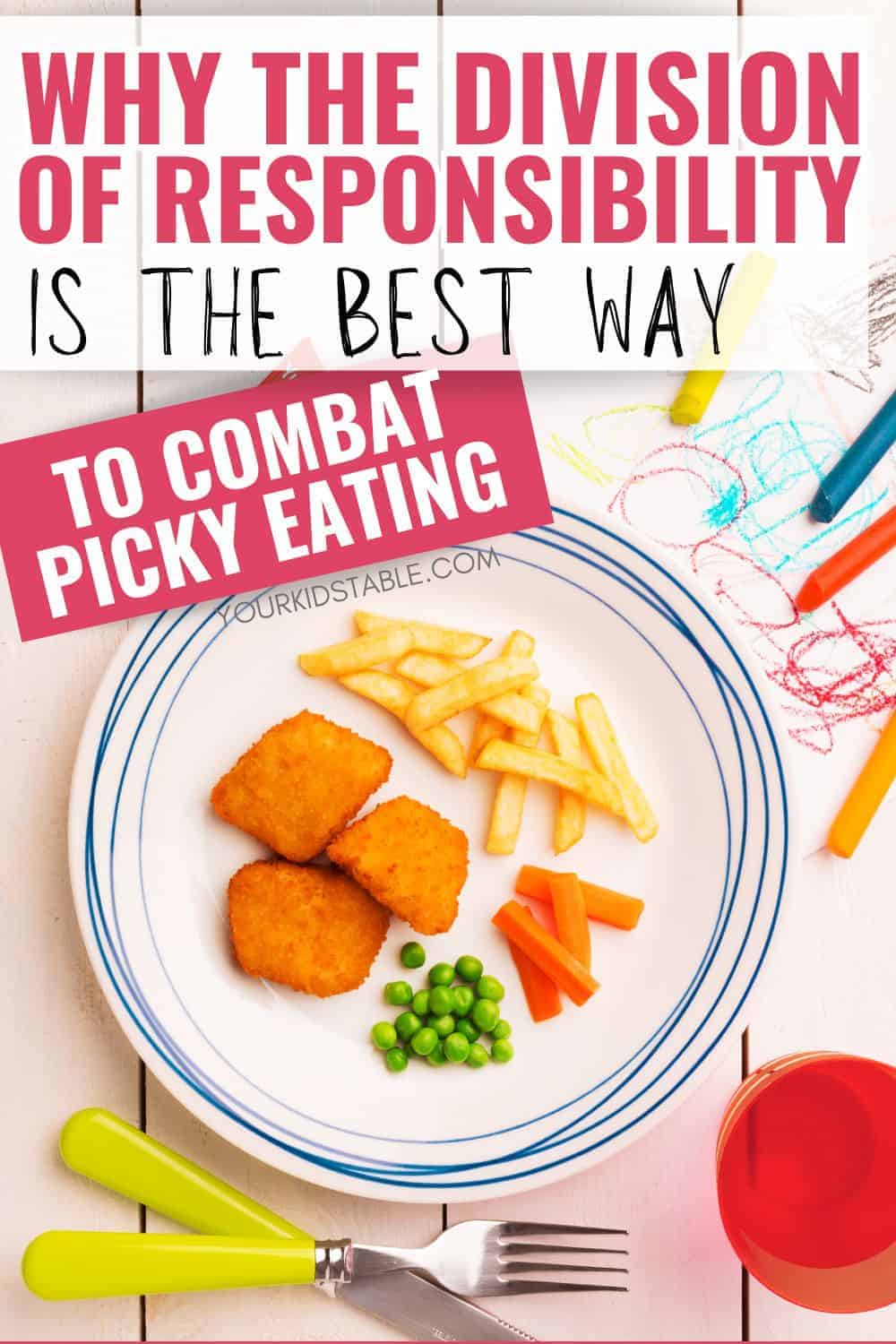
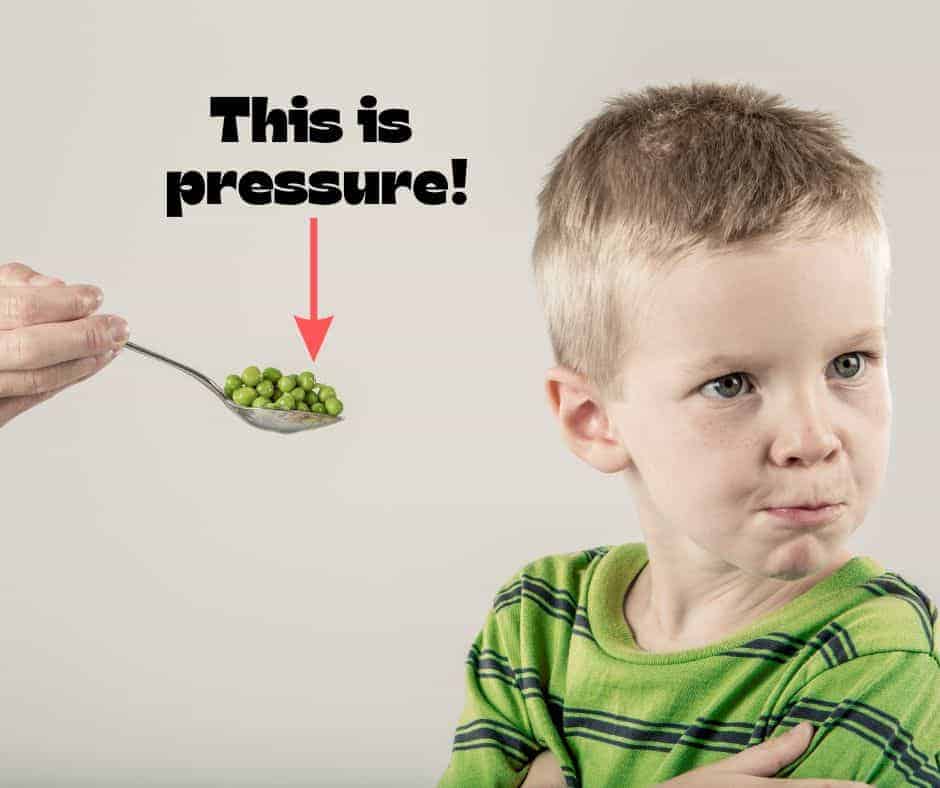
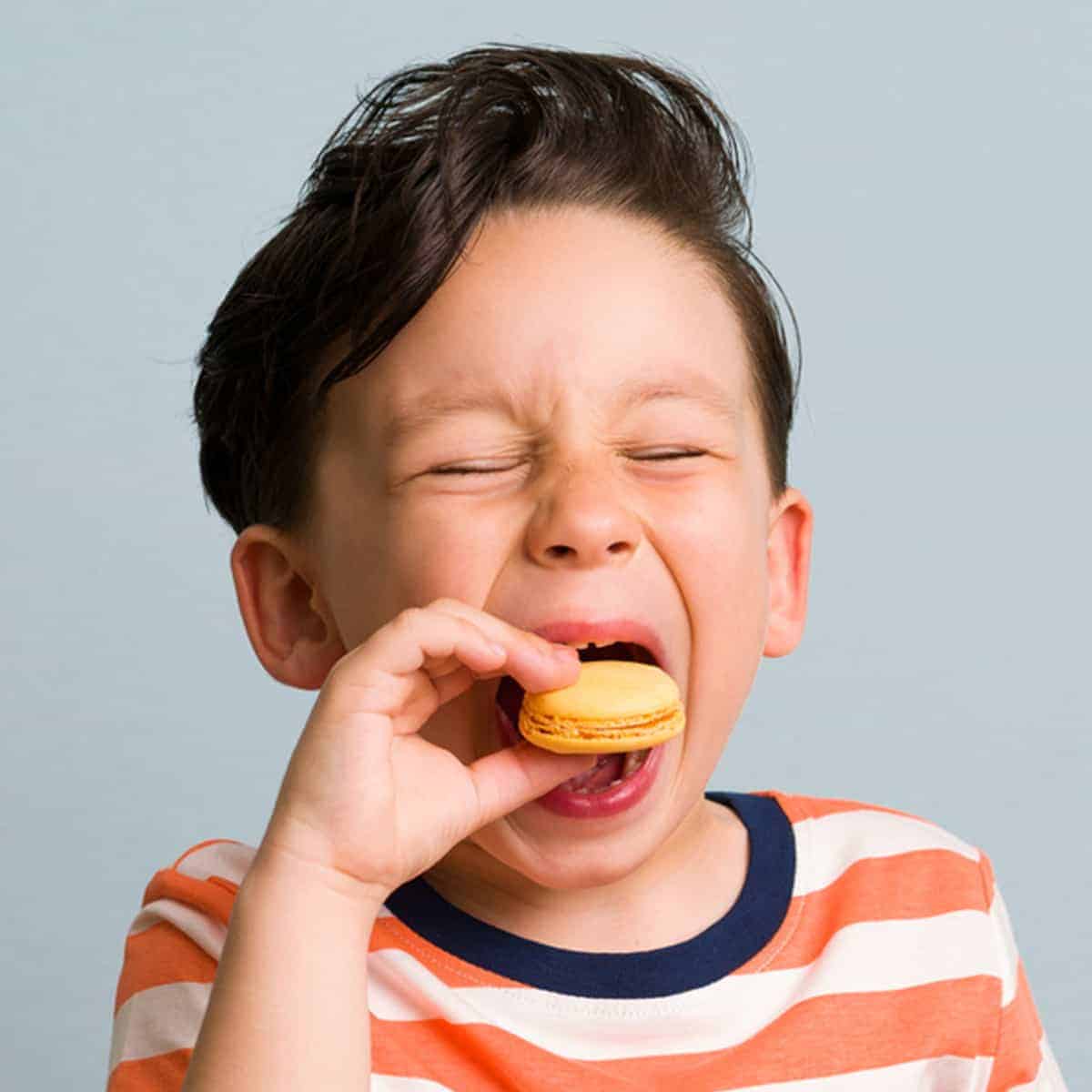

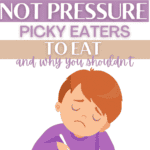
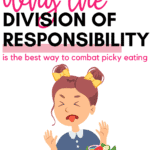
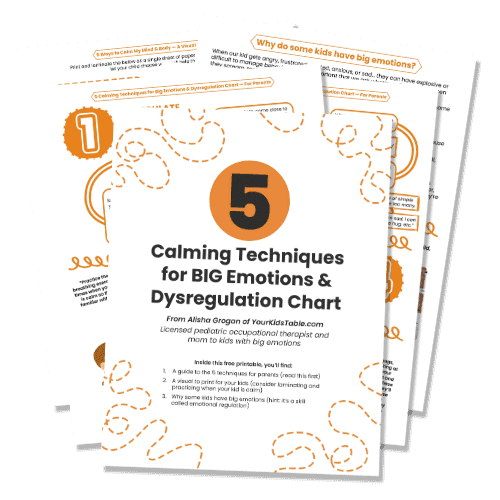
I’ve tried not pressuring before and a lot of other tactics mainly just offering 1 safe food on my 5 year olds plate (usually fruit) along with a meat and a side (both foods he never eats). I have never been able to remain consistent for more than 2-3 weeks because he just doesn’t eat. WHAT DO I DO IF HE JUST WONT EAT??? He would rather starve than eat a new food….. and then he’s grumpy and I have 2 other kids under 4 to manage…
Hi Jess! Thanks for reaching out! It’s challenging for sure! I’d suggest continuing with no pressure and then try to do some investigation as to what the underlying cause may be. See this post on why kids don’t eat well.
We also have a free workshop that covers what you learned here in a lot more detail!
Best,
Kalyn
Everything that I’m reading about pressuring creating food/feeding aversion makes it sound like I’ve permanently damaged my daughter and caused issues that will affect her for the rest of her life and give her a bad relationship with food. She’s 12 months old. If I stop all pressure can this be resolved? Or did I seriously do long term damage?
Hey Rebecca,
Please don’t beat yourself up about this! A few adjustments to make mealtime positive and pressure free can make all the difference 🙂 A great place to start is our free table foods workshop. You can save your seat HERE. Please reach out with any questions at all!
Best,
Andrea
My daughter 2.6 years old has been diagnosed with a feeding aversion she was okay with eating from food pouches just not solid foods/table foods. She recently was in the hospital for losing 2 pounds but test results were fine. We saw an OT and she force fed our baby and said that’s the only way she’ll eat since she’s breast fed. Obviously we listened to the medical professional & it feels like torture. She seems to hate me after it makes me sad. I feel like from reading this article I’m a bad parent she’s a toddler I pray she can get through this without it being life long…someone even said she would need a feeding tube I’m lost stressed out & out of all answer’s.
Hey Rani,
So sorry you are dealing with this. It is not your fault and you are not a bad parent! You are trying to do what is best for your child and what you were told by a professional. There are different techniques utilized in feeding therapy. We do follow the no pressure approach as it does have more success long term! If you haven’t yet, I’d check out our free workshop for some first steps as it sounds like this is more of what you are looking for. You can save your seat here!
Best,
Desiree
My son 3 years old never asks for food or gets excited on seeing food on plate. When he gets hungry he asks for chocolates and candies. I fed him simple n selected food by making him involved in phone.
He doesn’t like soft food except banana. He doesn’t open full mouth when I am feeding him.
Hi Monicka! Thanks for reaching out! Because you mentioned he doesn’t like soft foods and doesn’t open his mouth when feeding him, it could be a sensory or oral motor issue! Try some sensory and oral motor exercises- use a toothbrush to brush the insides of his mouth between feedings, allow him to touch/feel/play with his food, make silly faces, sip from straws, etc. All of these exercises can help strengthen his oral muscles and sensory sensitivities, which can help him eat better! Hope that helps!
Best,
Kalyn
Hi – just wondering if there’s any updates on your daughter, I’m currently in the same situation with my 1yr old . (20 months)
He won’t eat ANY solids, or have any liquids other than milk in his bottle.
I’m desperate for help.. we’re on the waiting list to see an OT.
Thank you for all your articles, it really compasses everything we are experiencing regarding my 1 year old. We have been working with a dietitian and natural-path since he was 8 months old and first noticed the food aversions. We have a no pressure environment, he sits at the table and I offer small snacks typically of 3-4 different types and all one at a time. My son has never once swallowed food. Bacon which would be a good item he always places into his own mouth will only be sucked on but never swallowed. Most food all just gets thrown on the floor. We keep the environment neutral and calm and we have seen zero improvement at all. We always eat beside him as well and he just started daycare 3 weeks ago and is not being sent home because they are worried he is not eating anything. I am suppose to go back to work in 1 week and I’m terrified I won’t be able to due to his eating. If you would have any advice for him I would be forever grateful as I am feeling very overwhelmed by this. Thank you so much.
We’re struggling.always have done. Shes Asd and been extremely picky and sensory around food. Ill admit we have pressurised her or used bribery as she wouldn’t eat anything. We did relax it and although limited foods she was eating. She’s been ill recently and we’re now back to square 1. Pocketing food, chewing with refusal to swallow and just refusing to eat. I find it extremely hard to stay calm. I’m in desperate need of help.
Hi Louise,
Picky eating can be so tough! Especially when sickness hits! Give yourself and her a bit of time to get back to where you were before she got sick. It is really common to take many steps back after illness. Encouraging a no-pressure, positive family mealtime is a great place to start. Our free picky eating workshop would be a good place for you to start. You can save your seat HERE.
Best,
Andrea
My son is a preemie born 3 months early and he had a feeding tube in the nicu. He’s 14 months 11 months corrected. Serious weight issues and pukes if something gets stuck in his throat. Very sensitive gag reflux plan acid reflux. I am pressuring him because all I hear are drs in my head saying they will put a ng tube in him. He’s only 15.8 pounds and I’m scared for him. We are seeing a early intervention person for his eating but I’m so desperate and I’m stressing him out I know it. I think he’s scared of his high chair now.
Hi Kassidy! So sorry to hear about your son’s health/eating issues. We understand how stressful it can be! We definitely recommend talking with your doctor, since his weight is a concern. It’s great that you’ll be seeing an early intervention specialist in person soon! It will be so beneficial to get some one on one, hands on support for him. In the meantime, try not to pressure him to eat. You may also try some oral motor exercises to help with his sensitive gag reflex. Oral motor exercises can help desensitize his reflux and help strengthen his oral muscles! Use a toothbrush to brush the insides of his mouth between feedings. Click here for a list of more ideas!
Best,
Kalyn
Hi. We have been attempting these strategies for a few weeks. Unfortunately our nanny who feeds our almost-2yo daughter breakfast and lunch is still using some pressure techniques. Are we totally screwed if the nanny can’t get on board? This strategy goes against every fiber of her being, and us trying to explain it to her has led to tension. As if we need any more drama around mealtime.
Hey Natalie,
It’s a hard situation to be in. While we have seen progress when it’s not completed at all meals, it does make it harder to work through. I’m not sure if you’ve seen our free workshop or not, but possibly getting your nanny to watch it might help? If she’s willing! You can save your seat HERE. Also after sign up, you do get a replay available for 48 hours if that will work better time wise! Hope that helps!
Best,
Desiree
Hi! When we introduce the family style dinner, and our kids choose not to eat much, do you offer a large snack before bed? I’m afraid to put them to bed hungry, but also afraid they’ll start to depend on the bedtime snack instead of eating dinner and trying new foods.
Hey Kelly,
Great question and Alisha will be answering this today on a FB Live if you want to join in! But, typically you can do this “sometimes” but you do want to make sure that they don’t connect it with because they didn’t eat. And also making sure that the whole family is having snack too!
Best,
Desiree
This spoke to me today! I am struggling immensely with a five year old who has been a challenge with food as long as I can remember. She is extremely picky and sensitive. She will happily go all day without eating if her foods or snacks are not available. Has done so with daycare and preschool.
She is also in the lowest growth percentile, falling off the chart in her kindergarten physical. Needless to say I worry a lot about her eating enough and have done all of the wrong things to try to change that! I have seen this same child eat adult portions of her favorite foods, so I don’t think this is a physical issue.
My question is, what do you do about dessert if the child only chose to eat a handful of olives for dinner while everyone else ate? Do you offer dessert? I’m afraid my child will hold out for dessert to fill her tummy, but to withhold feels like pressuring. HELP!
Hey Wendy,
So happy that this article was helpful for you!! We can understand the worry! We treat dessert as any other food. We do recommend either serving dessert as part of the meal, or offering it only sometimes depending on your family dynamic. We do follow closely with the DOR regarding mealtimes, if you haven’t seen our free workshop yet, this is really helpful in sorting all this out! You can save your seat here
Best,
Desiree
Hi! How many different types of food should an 18 month old eat? I read somewhere on your website that it should be 20 – does this include fresh fruits and vegetables? Also, if I offer avocado toast one day and peanut butter toast another, does it count as one food (because they both use a bread base) or as different foods? Thank you!! Trying to understand my son’s eating habits with your resources.
Hello,
Thanks for reaching out. I think the number you are referring to, is looking at picky eaters which are identified eating less than 20 foods. For each food you would count individually. If there are 2 kinds of bread, but same texture it would still only be 1, but if they are different texture it can count as 2. Peanut butter and avocado would be 2 different foods.
Hope that helps!
Best,
Desiree
I am a Pediatric OT and would love to be able to print out this article to give to parents. DO you have a link to do that so I don’t have to cut and paste. Thanks
Hey Mary,
You can provide parents with the link to the article. We do not have a printable version available. However cutting and pasting does not provide them with the source as well as links for understanding.
Best,
Desiree
My daughter is 13 years old and has been diagnosed as a super taster, which has made her an extremely picky eater. I have tried the divided plates adding a bite size of foods different from her normal foods she’ll eat. She refuses to even try it with the comment it doesn’t smell good. I know that some super tasters can actually taste the food just by smelling it due to the hypersensitive tastebuds. She will actually smell the food, wait a minute then say either “ok I’ll try it or no, it tastes horrible”
I have made meals plain for her like spaghetti noodles only with butter and Parmesan cheese but now it’s to the extreme she has to have a certain type of Parmesan cheese (has to have a nutty taste to it, cant be shaved, has to be shredded) or it tastes horrible.. I’ve tried many costly and less costly brands and different flavoring of Parmesan cheese.
I’ve tried every way possible to get her to try something new/different, limiting or omitting herbs and spices from foods, trying different brands of foods but nothing seems to work.
So my question is how can I get a super taster to try different foods?
Hey Robyn,
Thanks for reaching out to us! Seems like you have been really great at adapting her foods! I’d try to tackle this from the sensory side of things, by having her help you in the kitchen. Talk about the foods, how they smell, look and feel. If the smells are too much, you can try it more slowly in the kitchen, but have the same concept in a messy play activity. I’d also take the same approach as other picky eaters that we discuss with having No Pressure environment around eating as discussed in the article!
Best,
Desiree
I love your emails and advice 😁 I need some help with strategies on eating outside of meal times. I have a 10, 8 and 6 yr old twins. We are really pretty good at having 3 meals a day and trying to keeping snack time to certain times and quantities. They r a little older with more independence and we are running into them using their allowance for snacks at our local hockey rink, cvs etc. It was easier to structure things when they were younger and having a little harder time with their greater independence.
Thank you for all advice and time
Caarin
Hey Caarin,
Thanks for reaching out and loving our site 🙂 I’d try to have a talk with them to limit what they are eating when. If they are utilizing their own monehy they can purchase but set a paramater on how much they can have when. ie: You can have 1 snack that you want to eat between 3-4pm. Also trying to move dinner later if they had more snacks for hockey etc. Another route if they are really hungry between practice, etc. You can try to pack more healthier options and then again have dinner later to space it out so they are more hungry. I’d talk openly about what you decide with your kids!
Best,
Desiree
Hi Alisha, my son turned two few months ago, and for the past month or so, he has stopped eating foods he not only used to eat but really liked: would say yum, yum, ask for more, smile while eating. It’s only dinner food – does fine with breakfast and lunch still.
He does not snack between meals but we do offer him something small before bedtime if we had a very active day. (No milk between meals either: never had juice or much junk food; homemade desserts on holidays and tortillas chips if we go out to eat at a Mexican restaurant.)
My husband and I are on the same page that we won’t make different meals for him and we have sent him to bed without dinner or bedtime snack two times. If he doesn’t want to eat the food, he falls to the floor crying and screaming, “No!!!” as if he is being attacked. At first we thought, he was simply full and not hungry for dinner yet. When this first started, we let him get down from the table to go play and then before we’d start the bedtime routine, we’d offer to reheat his dinner – this was working at first and he would eventually eat his dinner.
However, now when he doesn’t want to eat what we have for dinner, he refuses to eat any of it, refuses his milk, refuses the reheat BUT then wants a snack, which we said no to. I’ve read several of your articles, but I haven’t noticed anything that relates to dinner only. Any advice when picky eating only shows up at one particular meal?
Hi Tracy,
We know how frustrating this can be!! Sometimes it can just be a “typical” picky eating phase in which sticking with the routine, etc will help them get through the hump! Take our quiz to see where you child is falling, plus receive recommendations bases on the category he falls in! Take the quiz here
Best,
Desiree
Hi, I have read your article twice and I am a little confused on how to apply this. I get the point about not pressuring your kid to eat. My husband and I recently had a meeting about how to deal with our picky eaters. We were both picky children and our parents both tried to deal with us by spankings for not eating, sending us to bed hungry, scoldings, etc. Those methods didn’t work on either of us. I am in my 30’s and I still don’t eat fruit or vegetables. My husband’s pickiness did not improve either. We both agree that our parents’ method did nothing to make us eat better or get used to the foods we were resisting, it just created a bad relationship between parent and child.
Now we are trying to figure out how to work with our own children and we are pretty clueless. I want them to eat better than I do and have fruit and vegetables as part of their regular diet.
One problem I have with both my girls is that they initially like something but then change their minds… as an example, I started making butternut squash soup for lunch about once a week some time back. They loved it at first, but now both whine and fuss about it and will spend up to 2-3 hours sitting at the table to get it down. I started making them fruit and yogurt smoothies for lunch twice a week, which again they loved at first but now complain about and take hours to eat.
I feel that I’ve tried to be more positive by saying things like “we can have story time as soon as you finish” or “if you eat fast enough we will still have time for X (fun activity) before we have to leave” rather than making threats, but I realize that’s still pressure.
One concern I have with the “no pressure” method is all the waste. I have read articles suggesting to just put a certain food on their plates but don’t require them to eat it, or just ask them to taste it and then throw out the rest. I can’t afford to buy food just to throw away, and I am too busy to spend time cooking food that will end up in the trash.
I have been trying to look up new recipes so they will like their food better. I recently tried a “kid friendly vegetable pizza” recipe and it was NOT a hit to say the least. I felt frustrated because it was more expensive than most dishes I prepare, much more work, and the whole goal was to give them something they would like, not create hours of struggle to get it into them.
So, if I go low pressure and say “you don’t have to eat lunch if you don’t want to” what next? Obviously they’ll be hungry. I can’t afford a second meal if they turn down the one I made, and I don’t want to waste the food I have cooked.
Thank you for any ideas about how to work with my kids. They are 5 and 6 years old.
Hey Liz,
We get it, it can be frustrating. I’m glad that you realize that having that pressure does not make for a successful relationship with food. Some of having your child be eating something and then later change their mind is considered normal. I’d recommend to take our picky eating quiz to see truly where you kids fall on the picky eating scale, and provide suggestions based on where they fall. Also keep an eye out for our free video workshop series as it will cover more on picky eating and steps to take! Take the quiz here: http://www.yourkidstable.com/picky-eating-quiz
Best,
Desiree